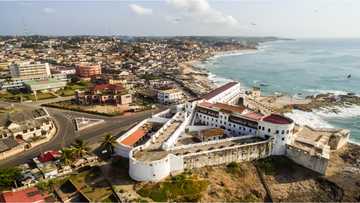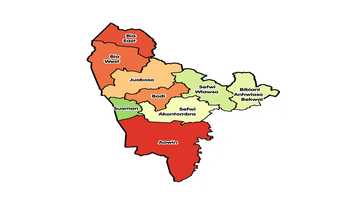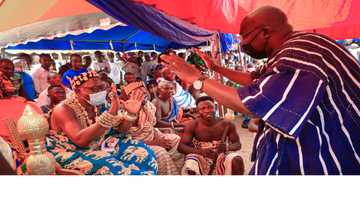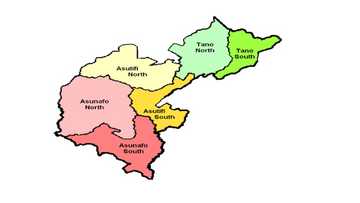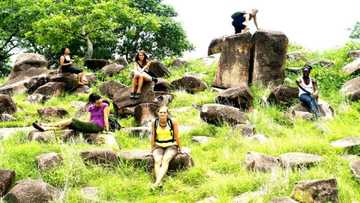List of all districts in the Savannah Region of Ghana
Ghana is one of the several African countries that use a form of the devolved governance system. The devolved units are known as regions in Ghana. The Savannah Region is one of the newest regions in Ghana. It is also the largest. For better governance, it has several smaller units – districts. There are seven districts in the Savannah Region of Ghana, and each has a capital.

Source: UGC
The Savannah Region is a relatively new region that was created in a 2019 constitutional referendum. It was part of six newly added areas. The Savannah Region was split from the Northern Region, which existed since independence. Aside from the Savannah, North-East Region was also carved out from the Northern Region.
Where is Savannah Region located?
The Savannah Region is located in the north-western part of Ghana. It is bordered by Ivory Coast (Cote d’Ivoire) to the east, the Bono and Ahafo regions to the south, the Northern and North East regions to the west, and the Upper West Region to the North.
What is the capital of the Savannah Region?
The capital of the Savannah Region is located in Damongo. It is a town in the West Gonja District. Damongo also serves as the district's capital being the major town (hence de facto capital) of the Damongo constituency.
What is the size and population of the Savannah Region?
Despite being one of the newer regions, the Savannah Region is the largest in Ghana. It spans 35,862 square kilometres and has a population of 581,368 (as of 2010 census). It comprises seven districts, with the majority of the people living in the urban areas.
List of districts in the Savannah Region
The revision of boundaries in 2019 that led to the Savannah Region's creation also included the proposed districts. They became constitutional after the revisions that were passed in parliament. These are the 7 districts in the Savannah Region provided by the Ghanaian constitution.
1. Bole District – Bole town

Source: UGC
The Bole District is one of the 260 Municipal and District Assemblies of Ghana. Following the 2019 constitution referendum, the district became part of the newly created Savannah Region.
Bole District was created in 2004 after being carved out of West Gonja District. It is located on the western part of the Savannah Region, where it borders Cote d'Ivoire (through the Volta River, which is one of the largest in Ghana). It also shares a border with Sawla/Tuna/Kabla District, West Gonja District, and the Ahafo Region.
Bole District has its capital in Bole Town. It is a small town mostly practicing farming and trading, but has been gradually growing as a mining town. The town is famous for being home to John Dramani Mahama, the ex-president of Ghana.
Bole District spans an area of 6,169 square kilometres. As of the 2010 census, it had a population of approximately 61,593. The main economic activity in the area is farming (cashew nuts farming, food farming, and economic trees). Mining is also becoming a major economic activity, with galamsey (illegal mining) and small scale community mining being on the rise.
2. Central Gonja District – Buipe
Central Gonja District is located towards the southern area of the Savannah Region. It is a relatively large district, that covers an area of 8,353 square kilometres, and has a population of 95,492 (2010 census). Its capital is located in Buipe town.
Central Gonja District is home to two main rivers in Ghana:
- The Black Volta that forms the southern boundary of the district
- The White Volta that passes through the district
Some small streams and rivers flow into these major rivers. On top of that, the area receives decent rainfall. As a result, the main economic activity in the region is farming. The most popular crops farmed in the region are maize, yam, cassava, rice, sorghum, groundnuts, cowpeas, and soybean.
Besides farming, people also practice fish production, with the Black and White Volta rivers being the main fish source. Other economic activities in the region include livestock keeping and mining (limestone).
3. West Gonja – Damongo

Source: UGC
West Gonja Municipal is another one of the seven administrative units that make up the Savannah Region. It is located in the region's central area, where it shares boundaries with Bole, Central Gonja, Sawla/Tuna/Kalba, West Gonja, and North Gonja districts. The municipal’s capital is located in Damongo.
Central Gonja has a total land area that measures 4,715 square kilometres. Protected areas occupy a huge chunk of the district. These include:
- Mole National Park
- Damongo scarp forest reserve
- Damongo Town forest reserve (artificial)
- Nyembong Forest reserve
- Bombi forest reserve (artificial)
- Kenikeni Forest Reserves
Western Gonja district is predominantly a farming region. It receives decent rainfall annual. There is also plenty of water from Mole River, White Volta River, and other small rivers and streams that come in handy during the dry season.
Fish farming is another economic activity in the region, which is supported by the rivers. On top of that, due to the heavy forest cover, forestry is another activity that is becoming increasingly popular in the area.
4. Sawla/Tuna/Kalba District – Sawla town
Sawla/Tuna/Kalba District assembly is located in the north-western part of the Savannah Region. It shares a boundary with Cote d'Ivoire and Bole, West Gonja, Wa Municipal, Wa East, and Wa West districts.
Sawla/Tuna/Kalba district was established in 2004. Before that, it was part of the Bole District Assembly. Its administrative capital is located in Sawla town. This rather small district spans a total of 4,601 kilometres. However, it has a high population, with the 2010 census estimating it to hold about 99,863 people.
5. East Gonja Municipal District – Salaga

Source: UGC
East Gonja Municipal is one of the Savannah Region districts, which lies on the extreme southeastern part. It is bordered by Central Gonja district to the west, the only Savannah Region district it shares a boundary with. To the north, it shares a boundary with Yendi and Tamale Districts of the Northern Region. To the south, it is bordered by the Brong Ahafo Region.
East Gonja District enjoys an important natural resource in the form of the White Volta River. It is thus not a surprise that agriculture is one of the main economic activities in the region.
East Gonja is one of the Savannah Region's large districts, with a total land size of 9,351 square kilometres. It also has a higher population than most other administrative units in the area – 135,450 people per the 2010 census. The district's administrative capital is in the town of Salaga.
6. North Gonja District – Daboya
North Gonja District is located in the northern part of the Savannah Region. It shares its borders with West Gonja, North Eastern Gonja, and Sawla/Tuna/Kalba districts. It spans 4,845 square kilometres and has a population of 43,547 as of the 2010 census.
North Gonja is a new district assembly, having been established in 2012. It was carved out of West Gonja districts and was inaugurated alongside several other new districts and municipalities. The town of Daboya was given the status of being the district's capital.
7. North East Gonja District – Kpalbe
North East Gonja is the newest district in the Savannah Region. It was established in 2019 and was carved out of the East Gonja Municipal. The town of Kpalbe was designated as the district's capital following the inauguration. Like most areas in the Savannah Region, the main economic activity in North East Gonja is farming.
Despite being a new region, Savannah thrives with numerous economic activities, from farming to mining, fishing trading, and more. It is also home to hidden gems such as the Mole National park. Furthermore, districts in the savannah region have many natural riches such as gold and limestone deposits and the water resources like White and Black Volta rivers.
Yen.com.gh has published a list of all 16 regions in Ghana and their capitals. They are divided into districts to make administration easier.
The most popular and one of the most populous regions in Ghana is the Greater Accra Region. Other include Central, Eastern, Ashanti, and Northern.
Source: YEN.com.gh

